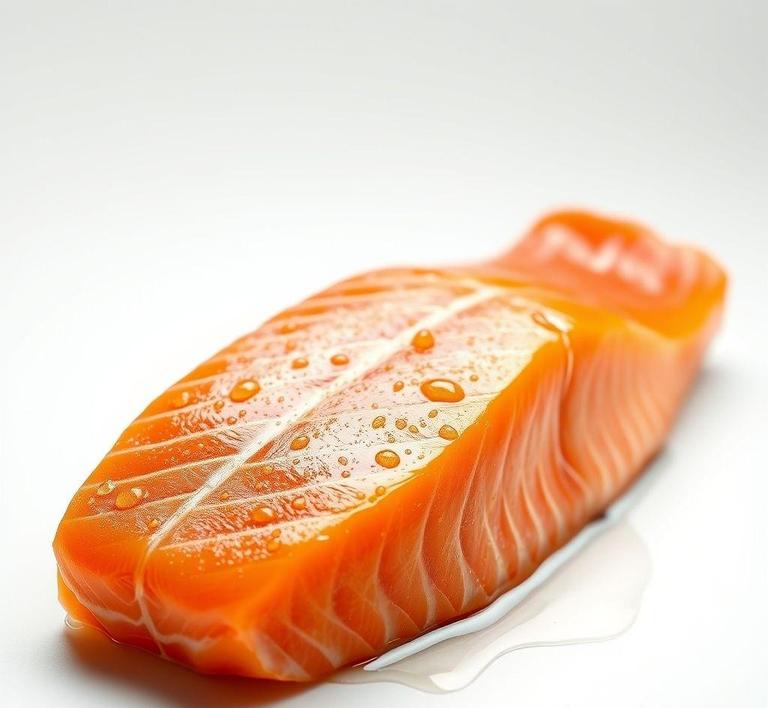If you’ve ever found yourself with more fresh salmon than you can eat in one go, you might be wondering: can you refreeze uncooked salmon without ruining its quality? The good news is, yes, you can refreeze uncooked salmon-though there are a few important steps to follow to ensure it stays safe and tasty. Freezing fish properly is key to preserving its texture and flavor, and understanding how to handle uncooked salmon before freezing is crucial to avoid any risk of foodborne illness. In this guide, we’ll walk you through everything you need to know about safely refreezing uncooked salmon, from prepping the fish to defrosting it later.
Can You Refreeze Uncooked Salmon?

The question of whether you can refreeze uncooked salmon is a common one, especially for those who occasionally purchase fish in bulk or are unsure about how long it can last in the freezer. The short answer is yes, you can refreeze uncooked salmon, but there are several important factors to consider in order to do so safely and without compromising its quality.
Refreezing salmon is generally not recommended if it has been thawed in the fridge for an extended period or if it has already been cooked. The process of freezing and thawing fish can cause significant changes in its texture, moisture content, and overall taste. However, if the salmon was thawed correctly (in the fridge or under cold running water) and hasn’t been left at room temperature for too long, it can typically be refrozen without major safety concerns. The critical factor here is controlling the temperature and ensuring that the salmon remains within safe guidelines to prevent the growth of harmful bacteria.
Fish, like all perishable foods, can be contaminated by pathogens if left at unsafe temperatures during the thawing process. This risk is particularly high for seafood because of its delicate nature and the way it can quickly absorb bacteria. Therefore, if the salmon has been left at room temperature for more than two hours, refreezing it could lead to foodborne illness. So, before you think about putting it back in the freezer, make sure that it has been handled with care at every step.
How To Refreeze Uncooked Salmon?
Refreezing uncooked salmon requires a little more attention than just tossing it back into the freezer. Here’s a step-by-step guide to ensure that you’re doing it correctly:
-
Thaw the Salmon Properly:
If the salmon was initially frozen, make sure it is thawed properly before refreezing. The best method for thawing is to place the salmon in the refrigerator for 12 to 24 hours. This ensures that it remains at a safe, cool temperature (below 40°F or 4°C) while it defrosts. Alternatively, if you’re in a rush, you can place the salmon in a sealed plastic bag and thaw it under cold running water.
-
Check for Freshness:
Before refreezing, check the salmon for any signs of spoilage. If the fish smells off, has an unusual color, or feels slimy, it’s best to discard it rather than risk foodborne illness. Only refreeze salmon that has been properly stored and appears fresh.
-
Wrap the Salmon Properly:
To avoid freezer burn and maintain the best possible texture, it’s crucial to wrap the salmon tightly. Use plastic wrap, aluminum foil, or a vacuum-sealed bag. If you’re using plastic wrap or foil, make sure the salmon is wrapped in multiple layers to ensure there is no exposure to air, which can degrade its quality.
-
Label the Packaging:
Write the date on the packaging so you can keep track of how long the salmon has been frozen. As a rule of thumb, it’s best to refreeze uncooked salmon within a few days of thawing, but it can remain in the freezer for up to 3 months if stored properly.
-
Refreeze Quickly:
Once the salmon is wrapped and ready, return it to the freezer as soon as possible. Try to freeze the fish in a location of the freezer that maintains a steady, consistent temperature (preferably 0°F or -18°C). The quicker the refreezing process, the better the salmon will retain its texture and flavor.
Quality Impact
While it is generally safe to refreeze uncooked salmon under the right conditions, it’s important to note that the quality of the fish can suffer. The process of freezing and thawing can impact several key qualities of the fish:
-
Texture:
Salmon’s delicate flesh is one of its most appealing features. When frozen and thawed, the water in the fish expands, causing the cellular structure to break down. This leads to a mushier texture after the fish is refrozen and then cooked. While this may not be as noticeable in recipes where the salmon is broken up (like in fish cakes or casseroles), it can affect the eating experience if the fish is grilled or baked.
-
Moisture Loss:
As salmon is thawed and refrozen, it loses some of its moisture. This can result in a drier final product. The loss of moisture can also make the fish less flavorful, as the natural juices and oils that contribute to the taste are diminished. This is especially true if the salmon is not properly wrapped or if it’s exposed to air in the freezer.
-
Flavor:
While the flavor of salmon doesn’t drastically change with refreezing, it can lose some of its freshness. Freezer burn (caused by exposure to air) can alter the taste and leave the fish with a slightly ‘off’ or stale flavor. This can be minimized by wrapping the fish securely and removing as much air as possible from the packaging.
-
Nutrient Loss:
The freezing process itself doesn’t destroy nutrients, but repeated freezing and thawing may cause a slight degradation in the omega-3 fatty acids that are found in salmon. However, this nutrient loss is typically minimal if the fish is stored properly.
While refreezing uncooked salmon is possible, it’s important to carefully follow proper handling techniques to ensure both food safety and quality. When done correctly, refreezing can be a useful way to avoid wasting fish, especially if you’ve only used part of a larger portion. However, keep in mind that the texture, flavor, and moisture content of the salmon may not be as optimal after refreezing. Therefore, it’s always a good idea to cook the fish sooner rather than later to get the best eating experience.
If you’re unsure about whether the salmon should be refrozen or if it has been exposed to unsafe temperatures for too long, it’s better to err on the side of caution and discard it. Ultimately, how you thaw, refreeze, and cook the salmon can make all the difference in maintaining the best possible outcome for both safety and flavor.
Is It Safe To Refreeze Uncooked Salmon?
Refreezing uncooked salmon is a topic that raises questions due to the delicate nature of fish and its perishable quality. In theory, refreezing raw salmon is safe, but it depends on how the salmon has been handled and stored throughout the process. The primary concern with refreezing uncooked salmon revolves around the quality of the fish, particularly its texture, flavor, and the potential for bacterial growth.
When you freeze salmon, the water content in the fish turns to ice, which can rupture the cell walls. This is why, after the salmon is thawed, the texture often becomes softer or mushier. Refreezing it will exacerbate these changes, resulting in a further loss of quality. If the salmon has been thawed and left at room temperature for a significant period (usually more than two hours), bacteria can begin to multiply, posing a risk of foodborne illness. However, if the salmon was thawed safely in the refrigerator and hasn’t been out for too long, refreezing is less likely to cause harm, though the quality may still suffer.
It’s essential to note that while refreezing uncooked salmon once or twice isn’t inherently dangerous, repeated freezing and thawing cycles increase the risk of bacterial growth and texture degradation. To maintain both the safety and quality of your salmon, you should avoid refreezing it more than once.
Signs That Uncooked Salmon Should Not Be Refrozen
Before even considering refreezing uncooked salmon, there are several indicators that it should be discarded instead. Salmon, like any other seafood, can go bad relatively quickly, and some signs that the fish should not be refrozen include:
- Off Odor: Fresh salmon has a clean, briny smell reminiscent of the ocean. If it develops a sour, ammonia-like, or overly fishy odor, it’s an indication that it’s no longer safe to eat. Any unpleasant odor signifies the onset of spoilage and bacterial growth, making refreezing risky.
- Slimy Texture: Fresh salmon should feel moist but not excessively slimy. If the fish feels slick to the touch or sticky, it’s a sign that bacteria have begun to break down the flesh. Once this happens, the texture deteriorates, and refreezing will only worsen the situation.
- Discoloration: Salmon should have a vibrant, pink to red color. If the fish starts to look dull, grayish, or brown, it’s a clear sign that it has started to spoil. Refreezing discolored salmon can further degrade the quality and flavor, so it’s best to discard it.
- Mushy Flesh: When salmon is thawed, its texture can change, but if it feels mushy or excessively soft even before cooking, it may have already gone past its prime. Refreezing fish with this texture only accelerates the breakdown of its flesh, and the result will likely be an unappetizing mess after cooking.
- Visible Freezer Burn: Freezer burn occurs when fish is exposed to air in the freezer, causing dehydration and oxidation. While it doesn’t necessarily make the fish unsafe, it significantly affects the texture and taste. If your salmon has visible freezer burn (patches of dried-out, grayish spots), it’s better to discard it rather than refreeze it.
Common Refreezing Mistakes
Refreezing uncooked salmon comes with its pitfalls, especially if proper care isn’t taken throughout the process. Here are some common mistakes that people make when refreezing salmon, which could result in compromised quality and safety:
- Thawing at Room Temperature: One of the biggest mistakes people make is thawing salmon too quickly at room temperature. While this speeds up the process, it allows the salmon to enter the “danger zone” (40°F-140°F), where bacteria can proliferate rapidly. Always thaw salmon in the fridge to keep it at a safe temperature.
- Repeated Freezing and Thawing: As mentioned earlier, while it’s generally safe to refreeze uncooked salmon once if it has been thawed properly, doing so more than once increases the risk of foodborne illnesses and results in a significant loss of texture and flavor. If you plan to refreeze salmon, do so only once, and ideally, cook it before freezing it a second time.
- Improper Storage: If uncooked salmon is not stored in an airtight container or wrapped properly, it will absorb odors from the freezer and suffer from freezer burn. Using plastic wrap followed by aluminum foil or a vacuum-sealed bag will help preserve the quality of the fish.
- Freezing Salmon for Too Long: Even though freezing salmon can preserve it for a long time, it doesn’t last forever. Most uncooked salmon should be consumed within three to six months for the best taste and texture. Freezing it for longer can cause it to deteriorate, even if the salmon looks fine on the outside.
- Refreezing After Cooking: Some people mistakenly believe it’s fine to refreeze cooked salmon. However, cooked fish can be just as prone to bacterial growth and textural degradation as raw fish when refrozen. In this case, it’s often better to refrigerate the cooked salmon and consume it within a couple of days instead.
Tips And Tricks For Refreezing Uncooked Salmon
If you’ve determined that your uncooked salmon is safe to refreeze, there are a few key strategies to ensure that the process is done correctly and to minimize the loss of quality.
- Thaw Safely: Always thaw your salmon in the refrigerator, not at room temperature or in warm water. This ensures the fish stays at a safe temperature while it defrosts, preventing bacterial growth.
- Portion the Fish: Instead of freezing the entire piece of salmon at once, consider portioning it into smaller servings. This makes it easier to only defrost the amount you need, and you avoid refreezing multiple times.
- Use Vacuum Sealing: Vacuum sealing is one of the best ways to preserve salmon during freezing. It removes air and prevents freezer burn, which can degrade the quality of the fish.
- Wrap it Well: If you don’t have a vacuum sealer, wrap the salmon tightly in plastic wrap, then place it in a resealable freezer bag or wrap it in aluminum foil. The goal is to prevent air exposure to reduce the risk of freezer burn.
- Label and Date: Always label your salmon with the date you froze it so you can track how long it’s been in the freezer. This helps you avoid leaving it in there for too long.
- Cook Before Refreezing: If you know you won’t be able to eat the salmon within a few days, it’s better to cook it first before freezing. Cooked salmon tends to hold up better after being frozen and doesn’t suffer as much from texture changes.
Conclusion
Refreezing uncooked salmon is possible, but it comes with both safety and quality concerns. To ensure that your salmon remains safe to eat, it’s crucial to thaw it properly, avoid leaving it out at room temperature for too long, and minimize the number of times it’s frozen and thawed. While refreezing once may not harm the fish, repeated cycles of freezing and thawing can cause bacterial growth and a significant drop in texture and flavor.
By being mindful of signs of spoilage, avoiding common mistakes, and following helpful tips for storage and freezing, you can preserve the freshness of your uncooked salmon and enjoy it safely at a later date. Always remember that the goal is not only to prevent foodborne illness but to preserve the delicate flavor and texture of one of nature’s most delicious and nutritious seafood offerings.


